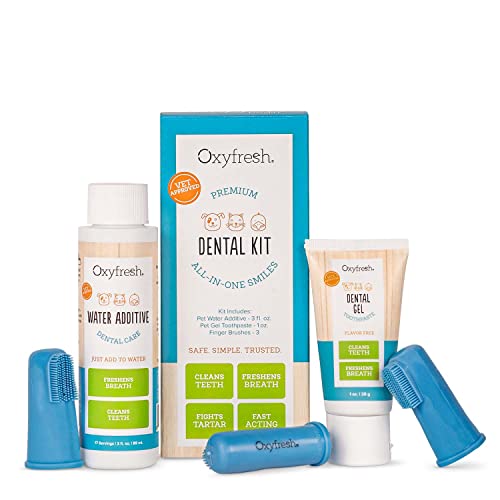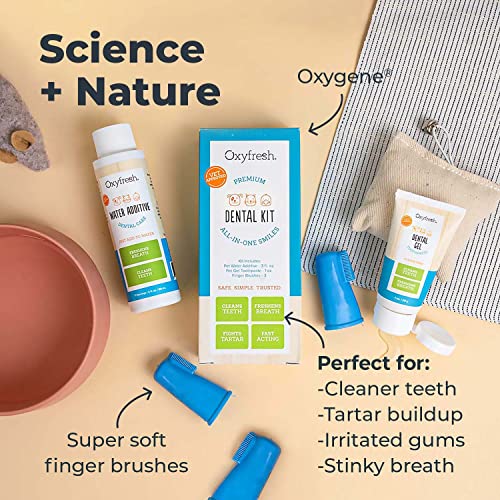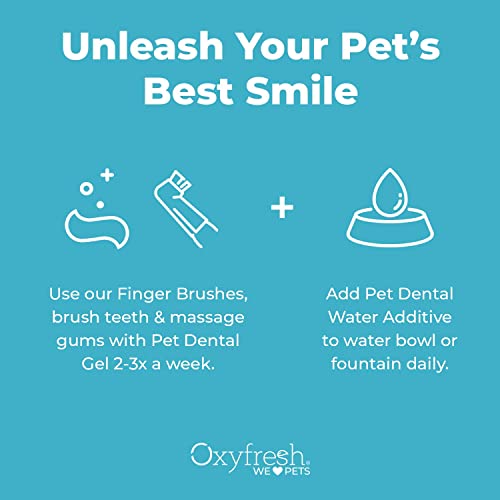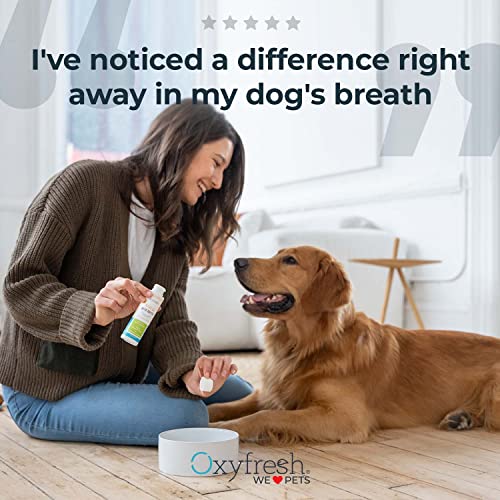








Oxyfresh Pet Dental Kit - Fresh Breath & Clean Teeth for Dogs & Cats - 1oz Toothpaste + 3oz Additive


Zinc Acetate
High RiskZinc acetate is a zinc salt of acetic acid. It is commonly used in various products for its role in providing zinc, an essential trace element, which is important for numerous biological functions.
Sustai Insights
Zinc acetate effectively serves as a zinc supplement and can enhance skin health and wound healing. However, regulatory warnings indicate high usage restrictions, and while it poses low risks for cancer, allergies, and reproductive toxicity, concerns exist regarding its persistence and bioaccumulation in the environment. Given these factors, the overall risk level is assessed as high, necessitating cautious usage and consideration of safer alternatives.
Propylparaben
High RiskPropylparaben is a member of the paraben family of preservatives commonly used in cosmetics and personal care products. It helps to inhibit the growth of harmful bacteria and mold, extending the shelf life of products and ensuring their safety during use.
Sustai Insights
Propylparaben functions effectively as a preservative, preventing microbial growth and maintaining product integrity. However, it has been linked to moderate concerns regarding allergies, endocrine disruption, and potential reproductive toxicity. Regulatory agencies have imposed restrictions on its use due to these health risks. Additionally, propylparaben may pose environmental hazards, including potential bioaccumulation. Overall, the ingredient is assessed as high risk, warranting cautious usage and consideration of safer alternatives.
Ci 75810
High RiskChlorophyllin-copper complex is obtained from chlorophyll, the green pigment in plants, and is commonly used in cosmetic and personal care products for its coloring and potential skin benefits. It serves as a stabilizer and can impart a green hue, enhancing product aesthetics.
Sustai Insights
Chlorophyllin-copper complex offers functional benefits as a colorant and stabilizer in formulations. However, its regulatory status is high-risk due to usage restrictions, and while health concerns like carcinogenicity, allergies, and reproductive toxicity are low, its potential environmental impacts, including persistence and bioaccumulation, are significant. Regulatory bodies have issued restrictions on its use, leading to an overall high-risk assessment. Safe usage practices should be observed, and alternatives like natural colorants may be considered.
Sodium Hydroxide
High RiskSodium hydroxide is a highly caustic and reactive inorganic compound commonly used as a pH adjuster in various products. It is effective in neutralizing acids and plays a role in the production of soaps and detergents.
Sustai Insights
Sodium hydroxide serves essential functions, particularly in adjusting pH levels, but poses significant health risks, including skin and eye irritation. It is subject to high usage restrictions due to its corrosive nature. Environmental concerns include its potential to pollute water sources and contribute to ecosystem damage. Regulatory bodies have imposed strict guidelines on its use, indicating a high-risk profile for products containing this ingredient. Safe handling practices are crucial, and alternatives include milder pH adjusters, emphasizing the need for caution in its application.
Sodium Benzoate
Medium RiskSodium benzoate is a preservative commonly used in food and cosmetic products to prevent microbial growth and extend shelf life. It is derived from benzoic acid and is effective at low concentrations, often used in acidic environments like beverages and condiments.
Sustai Insights
Sodium benzoate serves effectively as a preservative, contributing to product stability and safety. It is generally recognized as safe with low concerns for carcinogenicity, allergies, and reproductive toxicity, though it faces moderate use restrictions in some regions. Environmental risks include its potential as a pollutant, but it does not bioaccumulate significantly. Regulatory bodies have issued advisories regarding its concentration in products. Overall, the risk level is assessed as medium, with safe usage practices recommended. Alternatives such as potassium sorbate may provide similar benefits with potentially lower restrictions.
Methylparaben
Medium RiskMethylparaben is a member of the paraben family, commonly used as a preservative in cosmetic and personal care products. It helps inhibit the growth of bacteria and fungi, thereby extending the shelf life of products.
Sustai Insights
Methylparaben serves effectively as a preservative, protecting products from microbial growth, and is generally considered safe at low concentrations. However, it has been associated with low to moderate risks of allergies and endocrine disruption. Regulatory bodies have imposed some restrictions on its use, but it is still considered low risk for carcinogenicity and developmental toxicity. Safe usage practices recommend adhering to established concentration thresholds, and alternatives like phenoxyethanol or ethylhexylglycerin could be considered for those seeking more sustainable options. Overall, the risk level associated with methylparaben is medium.
Sodium Citrate
Low RiskSodium citrate is used in cosmetic formulations primarily as a buffering agent, helping to stabilize pH levels. It is derived from citric acid and is commonly found in various personal care products to enhance their efficacy and stability.
Sustai Insights
Sodium citrate offers functional benefits such as effective pH regulation and acts as a mild preservative. It is generally recognized as safe with low risks for cancer, allergies, and reproductive toxicity. Environmental concerns are minimal, with no significant pollutant potential or bioaccumulation. Regulatory bodies like the FDA and COSMOS have no major restrictions on its use. Overall, sodium citrate presents a low risk, making it a viable ingredient in cosmetic formulations. Safe usage practices should be followed, and alternatives are not typically necessary.
Water
Low RiskWater is a clear, colorless liquid essential for various biological processes. It serves as a solvent in formulations, facilitating the dissolution of other ingredients and enhancing product texture and application. Additionally, water plays a crucial role in hydration and is a key component in many cosmetic and personal care products.
Sustai Insights
Water is an effective solvent and hydrator, contributing to the texture and efficacy of formulations. It is biodegradable and generally regarded as safe, with low concerns regarding carcinogenicity, allergies, and reproductive toxicity. However, excessive water usage can lead to environmental concerns, particularly regarding resource depletion. Regulatory bodies do not impose restrictions on water use in cosmetics. Overall, the risks associated with water are low, making it a safe and essential ingredient.
Chamomilla Recutita (Matricaria) Extract
Low RiskChamomilla recutita (Matricaria) extract is derived from the flowers of the chamomile plant. It is commonly used in cosmetic formulations for its potential soothing and anti-inflammatory properties. This extract is often included in skin care products aimed at reducing irritation and enhancing skin comfort.
Sustai Insights
Chamomilla recutita extract offers functional benefits such as anti-inflammatory and soothing properties, making it valuable in cosmetics for sensitive skin. It is considered low risk regarding health concerns like carcinogenicity, allergenic potential, and neurotoxicity, with no significant environmental hazards reported. Regulatory bodies have not issued major restrictions. Overall, this ingredient can be safely utilized in cosmetic products with low health and environmental risk.
Chondrus Crispus (Carrageenan)
Low RiskChondrus crispus, commonly known as carrageenan, is a gelatinous polysaccharide derived from red algae. It is primarily used as a thickening, stabilizing, and gelling agent in food, cosmetics, and pharmaceuticals, providing texture and consistency to various products.
Sustai Insights
Carrageenan offers functional benefits such as effective thickening and stabilizing properties, making it valuable in food and cosmetic formulations. It is considered to have low health risk concerns regarding carcinogenicity, allergies, and reproductive toxicity, though moderate concerns exist for non-reproductive organ toxicity. Environmental impacts are minimal, as it is not known to be bioaccumulative or a significant pollutant. Regulatory bodies have not issued specific restrictions against its use, affirming a low overall risk assessment for this ingredient. Alternatives like agar-agar or pectin may be considered for those seeking substitutes.
Zinc Acetate
High RiskZinc acetate is a zinc salt of acetic acid. It is commonly used in various products for its role in providing zinc, an essential trace element, which is important for numerous biological functions.
Sustai Insights
Zinc acetate effectively serves as a zinc supplement and can enhance skin health and wound healing. However, regulatory warnings indicate high usage restrictions, and while it poses low risks for cancer, allergies, and reproductive toxicity, concerns exist regarding its persistence and bioaccumulation in the environment. Given these factors, the overall risk level is assessed as high, necessitating cautious usage and consideration of safer alternatives.
Sodium Citrate
Low RiskSodium citrate is used in cosmetic formulations primarily as a buffering agent, helping to stabilize pH levels. It is derived from citric acid and is commonly found in various personal care products to enhance their efficacy and stability.
Sustai Insights
Sodium citrate offers functional benefits such as effective pH regulation and acts as a mild preservative. It is generally recognized as safe with low risks for cancer, allergies, and reproductive toxicity. Environmental concerns are minimal, with no significant pollutant potential or bioaccumulation. Regulatory bodies like the FDA and COSMOS have no major restrictions on its use. Overall, sodium citrate presents a low risk, making it a viable ingredient in cosmetic formulations. Safe usage practices should be followed, and alternatives are not typically necessary.
Sodium Benzoate
Medium RiskSodium benzoate is a preservative commonly used in food and cosmetic products to prevent microbial growth and extend shelf life. It is derived from benzoic acid and is effective at low concentrations, often used in acidic environments like beverages and condiments.
Sustai Insights
Sodium benzoate serves effectively as a preservative, contributing to product stability and safety. It is generally recognized as safe with low concerns for carcinogenicity, allergies, and reproductive toxicity, though it faces moderate use restrictions in some regions. Environmental risks include its potential as a pollutant, but it does not bioaccumulate significantly. Regulatory bodies have issued advisories regarding its concentration in products. Overall, the risk level is assessed as medium, with safe usage practices recommended. Alternatives such as potassium sorbate may provide similar benefits with potentially lower restrictions.
Water
Low RiskWater is a clear, colorless liquid essential for various biological processes. It serves as a solvent in formulations, facilitating the dissolution of other ingredients and enhancing product texture and application. Additionally, water plays a crucial role in hydration and is a key component in many cosmetic and personal care products.
Sustai Insights
Water is an effective solvent and hydrator, contributing to the texture and efficacy of formulations. It is biodegradable and generally regarded as safe, with low concerns regarding carcinogenicity, allergies, and reproductive toxicity. However, excessive water usage can lead to environmental concerns, particularly regarding resource depletion. Regulatory bodies do not impose restrictions on water use in cosmetics. Overall, the risks associated with water are low, making it a safe and essential ingredient.
Chamomilla Recutita (Matricaria) Extract
Low RiskChamomilla recutita (Matricaria) extract is derived from the flowers of the chamomile plant. It is commonly used in cosmetic formulations for its potential soothing and anti-inflammatory properties. This extract is often included in skin care products aimed at reducing irritation and enhancing skin comfort.
Sustai Insights
Chamomilla recutita extract offers functional benefits such as anti-inflammatory and soothing properties, making it valuable in cosmetics for sensitive skin. It is considered low risk regarding health concerns like carcinogenicity, allergenic potential, and neurotoxicity, with no significant environmental hazards reported. Regulatory bodies have not issued major restrictions. Overall, this ingredient can be safely utilized in cosmetic products with low health and environmental risk.
Methylparaben
Medium RiskMethylparaben is a member of the paraben family, commonly used as a preservative in cosmetic and personal care products. It helps inhibit the growth of bacteria and fungi, thereby extending the shelf life of products.
Sustai Insights
Methylparaben serves effectively as a preservative, protecting products from microbial growth, and is generally considered safe at low concentrations. However, it has been associated with low to moderate risks of allergies and endocrine disruption. Regulatory bodies have imposed some restrictions on its use, but it is still considered low risk for carcinogenicity and developmental toxicity. Safe usage practices recommend adhering to established concentration thresholds, and alternatives like phenoxyethanol or ethylhexylglycerin could be considered for those seeking more sustainable options. Overall, the risk level associated with methylparaben is medium.
Chondrus Crispus (Carrageenan)
Low RiskChondrus crispus, commonly known as carrageenan, is a gelatinous polysaccharide derived from red algae. It is primarily used as a thickening, stabilizing, and gelling agent in food, cosmetics, and pharmaceuticals, providing texture and consistency to various products.
Sustai Insights
Carrageenan offers functional benefits such as effective thickening and stabilizing properties, making it valuable in food and cosmetic formulations. It is considered to have low health risk concerns regarding carcinogenicity, allergies, and reproductive toxicity, though moderate concerns exist for non-reproductive organ toxicity. Environmental impacts are minimal, as it is not known to be bioaccumulative or a significant pollutant. Regulatory bodies have not issued specific restrictions against its use, affirming a low overall risk assessment for this ingredient. Alternatives like agar-agar or pectin may be considered for those seeking substitutes.
Propylparaben
High RiskPropylparaben is a member of the paraben family of preservatives commonly used in cosmetics and personal care products. It helps to inhibit the growth of harmful bacteria and mold, extending the shelf life of products and ensuring their safety during use.
Sustai Insights
Propylparaben functions effectively as a preservative, preventing microbial growth and maintaining product integrity. However, it has been linked to moderate concerns regarding allergies, endocrine disruption, and potential reproductive toxicity. Regulatory agencies have imposed restrictions on its use due to these health risks. Additionally, propylparaben may pose environmental hazards, including potential bioaccumulation. Overall, the ingredient is assessed as high risk, warranting cautious usage and consideration of safer alternatives.
Ci 75810
High RiskChlorophyllin-copper complex is obtained from chlorophyll, the green pigment in plants, and is commonly used in cosmetic and personal care products for its coloring and potential skin benefits. It serves as a stabilizer and can impart a green hue, enhancing product aesthetics.
Sustai Insights
Chlorophyllin-copper complex offers functional benefits as a colorant and stabilizer in formulations. However, its regulatory status is high-risk due to usage restrictions, and while health concerns like carcinogenicity, allergies, and reproductive toxicity are low, its potential environmental impacts, including persistence and bioaccumulation, are significant. Regulatory bodies have issued restrictions on its use, leading to an overall high-risk assessment. Safe usage practices should be observed, and alternatives like natural colorants may be considered.
Sodium Hydroxide
High RiskSodium hydroxide is a highly caustic and reactive inorganic compound commonly used as a pH adjuster in various products. It is effective in neutralizing acids and plays a role in the production of soaps and detergents.
Sustai Insights
Sodium hydroxide serves essential functions, particularly in adjusting pH levels, but poses significant health risks, including skin and eye irritation. It is subject to high usage restrictions due to its corrosive nature. Environmental concerns include its potential to pollute water sources and contribute to ecosystem damage. Regulatory bodies have imposed strict guidelines on its use, indicating a high-risk profile for products containing this ingredient. Safe handling practices are crucial, and alternatives include milder pH adjusters, emphasizing the need for caution in its application.
Transform your pet's dental care routine with the Oxyfresh Premium Pet Dental Kit, expertly formulated for dogs and cats. This all-in-one solution ensures fresh breath and healthy teeth, making dental hygiene simple and effective for every pet owner.
- Comprehensive Dental Care: Features a water additive and toothpaste infused with Oxygene®, effectively fighting plaque and neutralizing bad breath for a healthier mouth.
- Safe and Gentle Formula: Vet-approved ingredients are non-toxic, tasteless, and odorless, ensuring even the pickiest pets enjoy their dental routine without harmful additives.
- Convenient All-in-One Kit: Includes a 3 oz. water additive, 1 oz. toothpaste, and three finger toothbrushes, providing everything needed for an easy at-home dental care regimen.
- Effective for All Pets: Designed for both dogs and cats, this kit adapts to the needs of every furry friend, promoting oral health across different breeds and sizes.
- Customer Trusted: With positive reviews from pet parents, this dental kit delivers reliable results, ensuring your pets feel their best between vet visits.
Subscribe & Save with Sustai
- Best Price Guarantee: Always enjoy the lowest prices on sustainable home essentials.
- No Surprises: We’ll notify you before shipping. No hidden fees, ever.
- You’re in Charge: Change, pause, or cancel your subscription anytime with ease.
- Eco-Friendly Deliveries: Our grouped shipments mean less packaging and lower emissions.
Join us on a sustainable journey. Special offers for a limited time! Prices and promotions may change.
Recommended Products
Transform your pet's dental care routine with the Oxyfresh Premium Pet Dental Kit, expertly formulated for dogs and cats. This all-in-one solution ensures fresh breath and healthy teeth, making dental hygiene simple and effective for every pet owner.
- Comprehensive Dental Care: Features a water additive and toothpaste infused with Oxygene®, effectively fighting plaque and neutralizing bad breath for a healthier mouth.
- Safe and Gentle Formula: Vet-approved ingredients are non-toxic, tasteless, and odorless, ensuring even the pickiest pets enjoy their dental routine without harmful additives.
- Convenient All-in-One Kit: Includes a 3 oz. water additive, 1 oz. toothpaste, and three finger toothbrushes, providing everything needed for an easy at-home dental care regimen.
- Effective for All Pets: Designed for both dogs and cats, this kit adapts to the needs of every furry friend, promoting oral health across different breeds and sizes.
- Customer Trusted: With positive reviews from pet parents, this dental kit delivers reliable results, ensuring your pets feel their best between vet visits.

You can have at most 2 Sustainable Steals products in your cart
Customer Reviews
Customers’ View
Customers appreciate the effectiveness and ease of use of the Oxyfresh Pet Dental Kit. Many highlight the pleasant smell, noting it significantly improves their pets' breath without strong odors. Users commend the product's functionality, stating it provides better results than vet cleanings and is a cost-effective solution for maintaining dental health at home. The inclusion of both a water additive and toothpaste simplifies the dental care routine for pets. However, some concerns were raised regarding the size of the toothbrushes, which may not be suitable for smaller pets, and a few customers expressed safety worries regarding certain ingredients. Overall, the product is viewed positively, aligning well with health-conscious and environmentally aware pet owners looking for reliable dental care solutions.
AI-generated from the text of customer reviewsThis product is rated 4.8 of 5.0 stars.
It has received 13 reviews.




